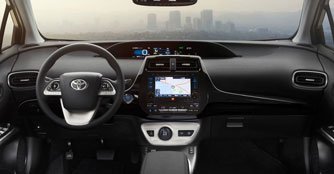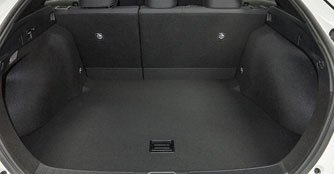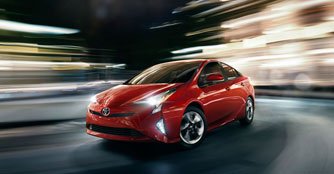Toyota Prius Hybrid 1.8 (A) First Drive Review
20 Nov 2015|22,630 views
When it comes to hybrids, the Toyota Prius is usually the first car that springs to mind. In fact, over eight million models have been delivered worldwide, which is nothing short of impressive.
Locally speaking, it wouldn't be a bold statement to say that the Prius is a strong-selling hybrid, with over 1,500 third generation models (taxis included) on the road and is indisputably one of the best in terms of its fuel consumption amongst hybrid cars, achieving some 32.6km/L in the Japanese test cycle.
And it gets better with the latest and fourth generation Prius you see here. It's the first car in Toyota's lineup to be based on the Toyota New Global Architecture (TNGA) modular platform, boasts 40km/L of fuel consumption on paper in the said cycle and it looks a hell lot sportier than before… But all I want to find out is whether Toyota has realised that it can't sell the car just based on fuel efficiency.
Exterior
Perhaps that's why the car now sports a bolder and crisper sheet metal. While the front end of the Prius is more evolution than revolution, it's the rear that garners the stares, thanks to the pair of dramatic boomerang-styled taillights that point firmly and sharply to the ground. As a result, the car is neither boring nor exciting to look at, which is no bad thing because it remains to be easy on the eyes.
Locally speaking, it wouldn't be a bold statement to say that the Prius is a strong-selling hybrid, with over 1,500 third generation models (taxis included) on the road and is indisputably one of the best in terms of its fuel consumption amongst hybrid cars, achieving some 32.6km/L in the Japanese test cycle.
And it gets better with the latest and fourth generation Prius you see here. It's the first car in Toyota's lineup to be based on the Toyota New Global Architecture (TNGA) modular platform, boasts 40km/L of fuel consumption on paper in the said cycle and it looks a hell lot sportier than before… But all I want to find out is whether Toyota has realised that it can't sell the car just based on fuel efficiency.
Exterior
Perhaps that's why the car now sports a bolder and crisper sheet metal. While the front end of the Prius is more evolution than revolution, it's the rear that garners the stares, thanks to the pair of dramatic boomerang-styled taillights that point firmly and sharply to the ground. As a result, the car is neither boring nor exciting to look at, which is no bad thing because it remains to be easy on the eyes.
 |
The Prius has also swopped its baggy suit for a sleeker and sharper-looking one. At 4,540mm long, 1,760mm wide and 1,470mm tall, the hybrid is 60mm longer, 15mm wider and 20mm lower than its predecessor, allowing it to appear more dynamic and planted on first glance.
In that sense, it will not come as a surprise if the car is going to be marketed based on its good looks when it arrives in Singapore next January. With its streamlined and optimised sheet metal, the Prius has, without a doubt, looks that will grow on you.
While it doesn’t have sensual curves that will set your heart on fire, it does possess detailed angles and bold lines that will set it apart from the boring looks of previous Prius models.
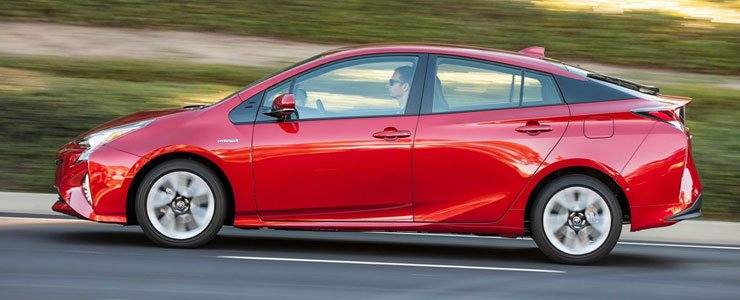 |
Interior
The changes are less dramatic here but Toyota has certainly tidied up the dash, made small tweaks that has shown big differences in terms of ergonomics and added a new steering wheel design.
The centre console has been modernised and contrasted with white accents against the piano black plastics while buttons now click with a tactile feel when depressed. The position of the stubby, spring-loaded gear selector has been moved slightly for the purpose of better ergonomics and is now less upright than before, giving the driver a better control when shifting from 'D' to 'R' and 'B'.
The changes are less dramatic here but Toyota has certainly tidied up the dash, made small tweaks that has shown big differences in terms of ergonomics and added a new steering wheel design.
The centre console has been modernised and contrasted with white accents against the piano black plastics while buttons now click with a tactile feel when depressed. The position of the stubby, spring-loaded gear selector has been moved slightly for the purpose of better ergonomics and is now less upright than before, giving the driver a better control when shifting from 'D' to 'R' and 'B'.
Materials used here are definitely a few notches higher than its predecessor and you feel it the moment you step in. Thanks to ingenious designing, what you'll also feel is the improved head and legroom despite having the same wheelbase of 2,700mm as before.
More relevantly, the relocation of the hybrid batteries from the boot compartment to under the rear seats allows the luggage space to increase by 56 litres to 502 litres - more spacious than the Toyota Camry and the Toyota Mirai of 484 litres and 361 litres respectively.
More relevantly, the relocation of the hybrid batteries from the boot compartment to under the rear seats allows the luggage space to increase by 56 litres to 502 litres - more spacious than the Toyota Camry and the Toyota Mirai of 484 litres and 361 litres respectively.
 |
The Drive
With the 1.8-litre in-line four-pot powerplant that's matched to the consistent Continuously Variable Transmission (CVT), 71bhp from the motor and 97bhp from the engine is sent progressively to the front wheels. While figures appear to be modest, there's no doubting that the Prius gets up to speed speedily and steadily in real world conditions.
We managed to drive the previous generation Prius and the new one back to back. Round the ultra smooth track of Fuji Speedway, the new Prius proved to be a better rider than its predecessor, with a sound suspension and chassis that balance nicely between firm and comfortable. How it's going to fare on Singapore roads where bumps and humps are more readily available remains to be seen when we review the car again next year.
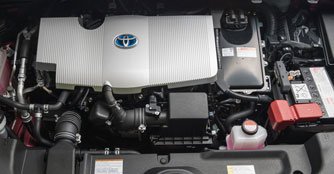
 While figures from the 1.8-litre engine are modest, it combines with the electric motor to produce capable performance results
While figures from the 1.8-litre engine are modest, it combines with the electric motor to produce capable performance results
What appears to be similar to its predecessor is the lack of drama behind the wheel. Insulation is top notch from the time you fire up the engine to the time you're throwing the car around corners with reckless abandon. As a result, it's the synthetic whine from the engine that you'll mostly hear - a characteristic that's commonly associated with hybrid cars.
With the 1.8-litre in-line four-pot powerplant that's matched to the consistent Continuously Variable Transmission (CVT), 71bhp from the motor and 97bhp from the engine is sent progressively to the front wheels. While figures appear to be modest, there's no doubting that the Prius gets up to speed speedily and steadily in real world conditions.
We managed to drive the previous generation Prius and the new one back to back. Round the ultra smooth track of Fuji Speedway, the new Prius proved to be a better rider than its predecessor, with a sound suspension and chassis that balance nicely between firm and comfortable. How it's going to fare on Singapore roads where bumps and humps are more readily available remains to be seen when we review the car again next year.

What appears to be similar to its predecessor is the lack of drama behind the wheel. Insulation is top notch from the time you fire up the engine to the time you're throwing the car around corners with reckless abandon. As a result, it's the synthetic whine from the engine that you'll mostly hear - a characteristic that's commonly associated with hybrid cars.
The car isn't without a bit of fun, though. The Prius' improved and sorted dynamics, lower centre of gravity and, not to mention Toyota's dependability and driveability, make for a car that's amusing to chuck around twisting turns on the racetrack. It's not quick, but it isn't boring either.
Conclusion
As the first car to be based on the new and capable TNGA modular platform, the Prius is endowed with sporty good looks, possesses sound driveability and has a reputation for reliability. This car is likely to remain the leading light for Toyota's hybrid powertrains for years to come.
With that many more advantages the latest Prius has over its predecessors, perhaps Toyota has indeed come to a realisation that it can't sell the car just based on fuel efficiency…
Conclusion
As the first car to be based on the new and capable TNGA modular platform, the Prius is endowed with sporty good looks, possesses sound driveability and has a reputation for reliability. This car is likely to remain the leading light for Toyota's hybrid powertrains for years to come.
With that many more advantages the latest Prius has over its predecessors, perhaps Toyota has indeed come to a realisation that it can't sell the car just based on fuel efficiency…
When it comes to hybrids, the Toyota Prius is usually the first car that springs to mind. In fact, over eight million models have been delivered worldwide, which is nothing short of impressive.
Locally speaking, it wouldn't be a bold statement to say that the Prius is a strong-selling hybrid, with over 1,500 third generation models (taxis included) on the road and is indisputably one of the best in terms of its fuel consumption amongst hybrid cars, achieving some 32.6km/L in the Japanese test cycle.
And it gets better with the latest and fourth generation Prius you see here. It's the first car in Toyota's lineup to be based on the Toyota New Global Architecture (TNGA) modular platform, boasts 40km/L of fuel consumption on paper in the said cycle and it looks a hell lot sportier than before… But all I want to find out is whether Toyota has realised that it can't sell the car just based on fuel efficiency.
Exterior
Perhaps that's why the car now sports a bolder and crisper sheet metal. While the front end of the Prius is more evolution than revolution, it's the rear that garners the stares, thanks to the pair of dramatic boomerang-styled taillights that point firmly and sharply to the ground. As a result, the car is neither boring nor exciting to look at, which is no bad thing because it remains to be easy on the eyes.
Locally speaking, it wouldn't be a bold statement to say that the Prius is a strong-selling hybrid, with over 1,500 third generation models (taxis included) on the road and is indisputably one of the best in terms of its fuel consumption amongst hybrid cars, achieving some 32.6km/L in the Japanese test cycle.
And it gets better with the latest and fourth generation Prius you see here. It's the first car in Toyota's lineup to be based on the Toyota New Global Architecture (TNGA) modular platform, boasts 40km/L of fuel consumption on paper in the said cycle and it looks a hell lot sportier than before… But all I want to find out is whether Toyota has realised that it can't sell the car just based on fuel efficiency.
Exterior
Perhaps that's why the car now sports a bolder and crisper sheet metal. While the front end of the Prius is more evolution than revolution, it's the rear that garners the stares, thanks to the pair of dramatic boomerang-styled taillights that point firmly and sharply to the ground. As a result, the car is neither boring nor exciting to look at, which is no bad thing because it remains to be easy on the eyes.
The Prius has also swopped its baggy suit for a sleeker and sharper-looking one. At 4,540mm long, 1,760mm wide and 1,470mm tall, the hybrid is 60mm longer, 15mm wider and 20mm lower than its predecessor, allowing it to appear more dynamic and planted on first glance.
In that sense, it will not come as a surprise if the car is going to be marketed based on its good looks when it arrives in Singapore next January. With its streamlined and optimised sheet metal, the Prius has, without a doubt, looks that will grow on you.
While it doesn’t have sensual curves that will set your heart on fire, it does possess detailed angles and bold lines that will set it apart from the boring looks of previous Prius models.
In that sense, it will not come as a surprise if the car is going to be marketed based on its good looks when it arrives in Singapore next January. With its streamlined and optimised sheet metal, the Prius has, without a doubt, looks that will grow on you.
While it doesn’t have sensual curves that will set your heart on fire, it does possess detailed angles and bold lines that will set it apart from the boring looks of previous Prius models.
Interior
The changes are less dramatic here but Toyota has certainly tidied up the dash, made small tweaks that has shown big differences in terms of ergonomics and added a new steering wheel design.
The centre console has been modernised and contrasted with white accents against the piano black plastics while buttons now click with a tactile feel when depressed. The position of the stubby, spring-loaded gear selector has been moved slightly for the purpose of better ergonomics and is now less upright than before, giving the driver a better control when shifting from 'D' to 'R' and 'B'.
The changes are less dramatic here but Toyota has certainly tidied up the dash, made small tweaks that has shown big differences in terms of ergonomics and added a new steering wheel design.
The centre console has been modernised and contrasted with white accents against the piano black plastics while buttons now click with a tactile feel when depressed. The position of the stubby, spring-loaded gear selector has been moved slightly for the purpose of better ergonomics and is now less upright than before, giving the driver a better control when shifting from 'D' to 'R' and 'B'.
Materials used here are definitely a few notches higher than its predecessor and you feel it the moment you step in. Thanks to ingenious designing, what you'll also feel is the improved head and legroom despite having the same wheelbase of 2,700mm as before.
More relevantly, the relocation of the hybrid batteries from the boot compartment to under the rear seats allows the luggage space to increase by 56 litres to 502 litres - more spacious than the Toyota Camry and the Toyota Mirai of 484 litres and 361 litres respectively.
More relevantly, the relocation of the hybrid batteries from the boot compartment to under the rear seats allows the luggage space to increase by 56 litres to 502 litres - more spacious than the Toyota Camry and the Toyota Mirai of 484 litres and 361 litres respectively.
The Drive
With the 1.8-litre in-line four-pot powerplant that's matched to the consistent Continuously Variable Transmission (CVT), 71bhp from the motor and 97bhp from the engine is sent progressively to the front wheels. While figures appear to be modest, there's no doubting that the Prius gets up to speed speedily and steadily in real world conditions.
We managed to drive the previous generation Prius and the new one back to back. Round the ultra smooth track of Fuji Speedway, the new Prius proved to be a better rider than its predecessor, with a sound suspension and chassis that balance nicely between firm and comfortable. How it's going to fare on Singapore roads where bumps and humps are more readily available remains to be seen when we review the car again next year.
What appears to be similar to its predecessor is the lack of drama behind the wheel. Insulation is top notch from the time you fire up the engine to the time you're throwing the car around corners with reckless abandon. As a result, it's the synthetic whine from the engine that you'll mostly hear - a characteristic that's commonly associated with hybrid cars.
With the 1.8-litre in-line four-pot powerplant that's matched to the consistent Continuously Variable Transmission (CVT), 71bhp from the motor and 97bhp from the engine is sent progressively to the front wheels. While figures appear to be modest, there's no doubting that the Prius gets up to speed speedily and steadily in real world conditions.
We managed to drive the previous generation Prius and the new one back to back. Round the ultra smooth track of Fuji Speedway, the new Prius proved to be a better rider than its predecessor, with a sound suspension and chassis that balance nicely between firm and comfortable. How it's going to fare on Singapore roads where bumps and humps are more readily available remains to be seen when we review the car again next year.
What appears to be similar to its predecessor is the lack of drama behind the wheel. Insulation is top notch from the time you fire up the engine to the time you're throwing the car around corners with reckless abandon. As a result, it's the synthetic whine from the engine that you'll mostly hear - a characteristic that's commonly associated with hybrid cars.
The car isn't without a bit of fun, though. The Prius' improved and sorted dynamics, lower centre of gravity and, not to mention Toyota's dependability and driveability, make for a car that's amusing to chuck around twisting turns on the racetrack. It's not quick, but it isn't boring either.
Conclusion
As the first car to be based on the new and capable TNGA modular platform, the Prius is endowed with sporty good looks, possesses sound driveability and has a reputation for reliability. This car is likely to remain the leading light for Toyota's hybrid powertrains for years to come.
With that many more advantages the latest Prius has over its predecessors, perhaps Toyota has indeed come to a realisation that it can't sell the car just based on fuel efficiency…
Conclusion
As the first car to be based on the new and capable TNGA modular platform, the Prius is endowed with sporty good looks, possesses sound driveability and has a reputation for reliability. This car is likely to remain the leading light for Toyota's hybrid powertrains for years to come.
With that many more advantages the latest Prius has over its predecessors, perhaps Toyota has indeed come to a realisation that it can't sell the car just based on fuel efficiency…
Thank You For Your Subscription.






















